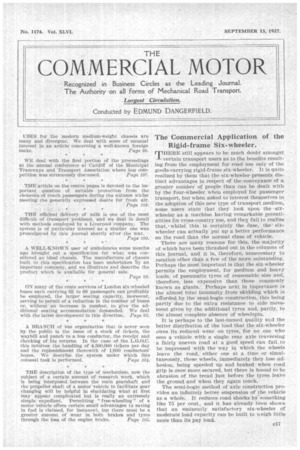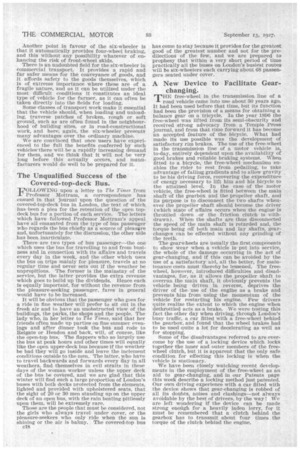The Commercial Application of the Rigid-frame Six-wheeler.
Page 39

Page 40

If you've noticed an error in this article please click here to report it so we can fix it.
rp HERE still appears to be much doubt amongst -. certain transport users as to the benefits resulting from the employment for road use only of the goods-carrying rigid-frame six-wheeler. It is quite realized by themthat the six-wheeler presents distinct advantages in respect of the conveyance of a greaser nurnbei of people than can be dealt with by the four-wheeler when employed for passenger transport, but when asked to interest themselves in the adoption of this new type of transport medium, some users state that they look upon the sixwheeler as a machine having remarkable potentialities for cross-country use, and they fail to realize that, whilst this is certainly the Case, the sixwheeler can actually put up a better performance on the road than the normal class of vehicle.
There are many reasons for this, the majority of which have been thrashed out in the columns of this journal, and it is, therefore, unnecessary to mention other than a few of the more outstanding. Perhaps the most important is that the six-wheeler permits the employment, for medium and heavy 'loads, of pneumatic tyres of reasonable size and, therefore, less expensive than those commonly known as giants. Perhaps next in importance is the almost total immunity from skidding which is afforded by the semi-bogie construction, this being partly due to the extra resistance to side Movement given by the additional tyres and, partly, to the almost complete absence of wheelspin.
It is perhaps to the last-named quality and the better distribution of the load that the Mx-wheeler owes its reduced wear on tyres, for no one who sees a vehicle with a single rear axle traversing a fairly uneven road at a good speed can fail„ to be impressed with the way in which the wheels leave the road, either one at a time or simultaneously, these wheels, immediately they lose adhesion, being speeded up and braked when road grip is once More secured, but there is bound to be abrasion of the tread just before the tyres leave the ground and when they again touch. • The semi-bogie Method of axle construction provides an infinitely better suspension of the vehicle as a whole. It reduces road shocks bi-sornething like 75 per cent., and it has already been shown that an eminently satisfactory six-wheeler of moderate load capacity can be built to 'weigh little more than its pay load. Another point in favour of the six-wheeler is that it automatically provides four-wheel braking, and this without any possibility whatever of enhancing the risk of front-wheel skids. There is au undoubted field for the six-wheeler in commercial transport. It provides a rapid and far safer means for the conveyance of goods, and it affords safety to the goods themselves, which is of extreme importance where these are of a fragile nature, and as it can be utilized under the most difficult conditions it constitutes an ideal type of vehicle for the farmer, as it can often be taken directly into the fields for loading. . Some classes of transport work make it essential that the vehicle should, when loading and unloading, traverse patches of broken, rough or soft ground, such as are often found in the neighbourhood of building sites, or in road-constructional work, and here, again, the six-wheeler presents many advantages over the ordinary machine. We are convinced that once users have experienced to the full the benefits conferred by such vehicles-there will be a 'rapidly increasing demand for them, and we think that it will not be very long before this actually occurs. and manufacturers would do well to be prepared for it.












































































































